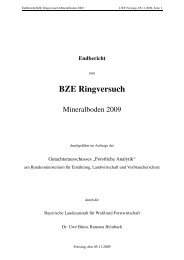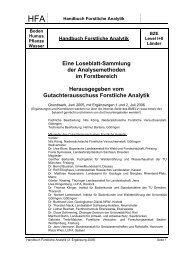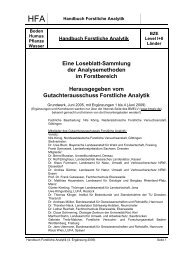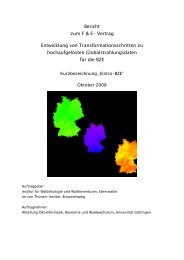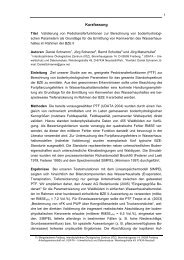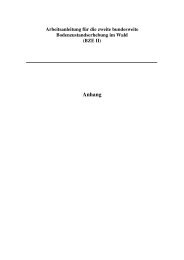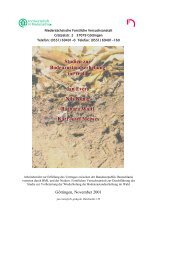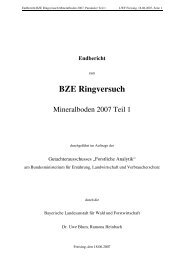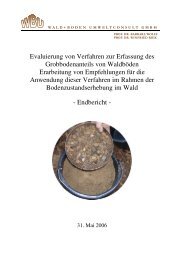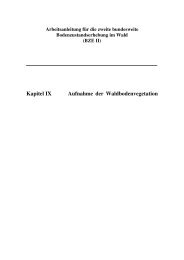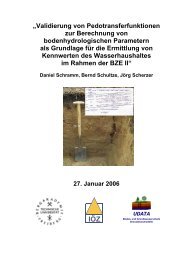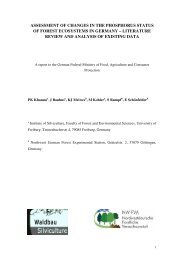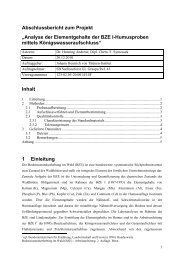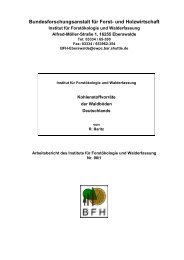assessment of changes in the phosphorus status of forest ...
assessment of changes in the phosphorus status of forest ...
assessment of changes in the phosphorus status of forest ...
You also want an ePaper? Increase the reach of your titles
YUMPU automatically turns print PDFs into web optimized ePapers that Google loves.
For <strong>the</strong> older compiled <strong>in</strong>formation on <strong>the</strong> use <strong>of</strong> soil test methods for <strong>forest</strong> soils<br />
refer to Ballard (1980). In <strong>the</strong>ir recent study (Mendham et al. 2002) compared<br />
different methods to dist<strong>in</strong>guish fertilized and unfertilized sites for determ<strong>in</strong><strong>in</strong>g<br />
available P and suggested that <strong>the</strong> use <strong>of</strong> CaCl2 soluble P provided <strong>the</strong> best results<br />
with respect to <strong>the</strong> growth responses <strong>in</strong> Eucalypt plantations. Khanna (1994)<br />
evaluated various <strong>in</strong>dices for measur<strong>in</strong>g P <strong>status</strong> <strong>of</strong> <strong>forest</strong> stands by us<strong>in</strong>g both plant<br />
based and soil based parameters from P<strong>in</strong>e and Eucalyptus sites. Plant based<br />
parameters were P concentrations <strong>in</strong> <strong>the</strong> foliage, f<strong>in</strong>e roots, and leaf litter, and plant<br />
bioassay ( 32 P uptake by roots) and phosphatase activity <strong>of</strong> f<strong>in</strong>e roots. Soil based<br />
parameters <strong>in</strong>cluded P extraction, anion exchange and Fe-impregnated paper,<br />
microbial P, phosphatase activity <strong>in</strong> soils, and P m<strong>in</strong>eralisation under laboratory<br />
conditions. He concluded that P content <strong>in</strong> <strong>the</strong> f<strong>in</strong>e roots, and Fe-impregnated paper<br />
may be most useful to assess P <strong>status</strong> <strong>of</strong> <strong>forest</strong> stands.<br />
The soil test methods were developed by <strong>in</strong>volv<strong>in</strong>g some basic soil chemical<br />
pr<strong>in</strong>ciples. Thus P extracted by <strong>the</strong>se methods does not provide any arbitrary value but<br />
a def<strong>in</strong>ed fraction <strong>of</strong> soil P. Some <strong>of</strong> <strong>the</strong>se methods have been used for <strong>forest</strong> soils,<br />
mostly to describe <strong>the</strong> P <strong>status</strong> <strong>in</strong> comparative situations, or to describe <strong>the</strong> immediate<br />
effect <strong>of</strong> fertilizer or o<strong>the</strong>r silvicultural treatments (fire, removal <strong>of</strong> harvest<strong>in</strong>g slash,<br />
w<strong>in</strong>drow<strong>in</strong>g, addition <strong>of</strong> th<strong>in</strong>n<strong>in</strong>g slash). Absolute available soil P values obta<strong>in</strong>ed by<br />
any <strong>of</strong> <strong>the</strong>se methods are difficult to calibrate for <strong>forest</strong> stands us<strong>in</strong>g growth or o<strong>the</strong>r<br />
responses and thus cannot be used to describe <strong>the</strong> long-term P supply<strong>in</strong>g <strong>status</strong> <strong>of</strong><br />
<strong>the</strong>se soils.<br />
There are two o<strong>the</strong>r ma<strong>in</strong> issues which should be addressed:<br />
1. As <strong>forest</strong> soils conta<strong>in</strong> high amounts <strong>of</strong> organic P, many <strong>of</strong> <strong>the</strong>se methods which<br />
use high pH solutions will extract excessive amount <strong>of</strong> organic matter, creat<strong>in</strong>g<br />
problems <strong>in</strong> <strong>the</strong> measurement <strong>of</strong> <strong>in</strong>organic P.<br />
2. Many <strong>forest</strong> soils are highly acid and it is possible that <strong>the</strong> amount <strong>of</strong> Al<br />
complex<strong>in</strong>g agent, e.g., F <strong>in</strong> Bray’s method may be too low to release P from<br />
soils. However repeated addition <strong>of</strong> NH4F solution <strong>in</strong> sequential extractions may<br />
overcome this problem, which arises because such methods were not developed<br />
for <strong>forest</strong> soils.<br />
64



